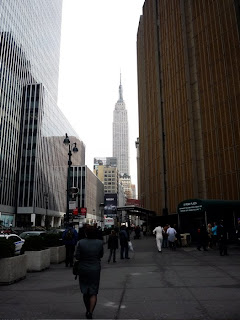(updated 2017) While lacking the mystique of nearby Gramercy Park,
Stuyvesant Square makes a pleasant destination for a walk. One certain advantage is that the fenced park is open to the public. No key is necessary.
Bounded by E. 15th Street to E. 17th Street and curiously bisected by Second Avenue, the park sits on land that once belonged to the Stuyvesant family. In 1836
Peter Gerard Stuyvesant (1778–1847) made the land available to the city with the understanding it would become a park. Planned in similar fashion to other squares, the park opened to the public in 1850 and became a fashionable residential destination in the latter half of the nineteenth century. The opening of
St. George's Church solidified the social standing of the area, especially boosted by the church's chief patron and warden,
John Pierpont Morgan.
 |
| Stuyvesant Square |
Subsequent renovations in the twentieth century modernized Stuyvesant Square. The eastern side now serves as gateway to many medical buildings, most of them modern. The park's western side features a statue of Peter Stuyvesant by
Gertrude Vanderbilt Whitney, peg leg and all, dating from 1940, and on the northeastern corner sits a statue of
Antonín Dvořák (1841–1904). The composer lived nearby for three years during the 1890s. The surrounding historic district, while relatively small, encloses several houses of worship, each with a fascinating story, and attractive row houses.
 |
statue of Peter Stuyvesant by Gertrude Vanderbilt Whitney
|
 |
| Friends Meeting House and Seminary |
The religious aspect of the square’s history becomes evident in a quick walk around. On the north side,
East End Temple, Congregation El Emet occupies a building at 245 East 17th St., an elegant French Renaissance town house designed by
Richard Morris Hunt in 1883. The congregation, founded after World War II, moved to the building in 2004, and its restored contemporary interior won much acclaim. (
Interior Design magazine).
On the south side of the square at 246 E. 15th St., the distinctive international style of
St. Mary's Catholic Church of the Byzantine Rite features prominent stained-glass windows set within high-arched concrete frames. Nearby, at the corner of E. 15th St and Rutherford Place, the 1860 red brick
Friends Meeting House and Seminary represents the Greek Revival tradition.
 |
| Chapel of St. George's |
St. George's Church and its companion chapel were built in the manner of the Romanesque Revival. The original church, built in 1846-1856, was destroyed by a fire in 1865 and then rebuilt. It originally featured two spires, but they were removed in 1889. During the time that financier
J. P. Morgan was involved with the church, the demographics of the surrounding neighborhood began to change as immigrants families with Jewish and Catholic religious backgrounds moved to the neighborhood. The church adapted to the times, opening of its pews and revising its doctrine to appeal to a broader base of the Episcopal Church. (
source: Wikipedia)
 |
| St. George's Church |
One of church's most famous members was composer and signer
Harry Thacker Burleigh, a descendent of slaves who introduced the sound and tradition of spirituals to a wide audience. Accepted to the National Conservatory of Music, then located at 126-128 East 17th Street, Burleigh not only assisted composer Antonín Dvořák with musical transcriptions but also introduced the composer to African American music. Burleigh joined St. George's Church in 1894 as a featured soloist. St. George's Church is part of the Parish of Calvary-St. George's, having merged with the Calvary Church on Gramercy Park North in 1975. Originally, a third church was part of the merger -
Church of the Holy Communion on 6th Avenue, the one that became the home of the
notorious Limelight Disco after the church closed.
 |
| E. 17th Street in the Stuyvesant Square Historic District |
Aside from the houses of worship, a walk around Stuyvesant Square reveals attractive apartment buildings and townhouses. Before exploring the area, grab a good cup of coffee and a homemade croissant at
Piccolo Café on 3rd Avenue.
 |
| entrance, Hotel 17, 225 E. 17th Street. |
While in the neighborhood, consider a follow-up walk to
Gramercy Park (
read more on this website) via "the Block Beautiful," the name for a stretch of well-maintained townhouses on E. 19th St. between Irving Place and Third Ave. Those with an interest in American history may want to visit the Theodore Roosevelt Birthplace National Historic Site at 28 E. 20th Street (
read more here). The area is rich in fine restaurants, comforting diners, and cozy spots for tea and coffee.
 |
| facade of house facing Stuyvesant Square, west side |
View Union Square, Stuyvesant Square, Gramercy Park in a larger map
Instagram and Hipstamatic photos from Sunday morning, February 19, 2012. More views at
this set on Flickr WOTBA.





Comments
Post a Comment